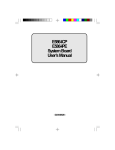Download Your ESPRIMO
Transcript
Operating Manual
FUJITSU Desktop
ESPRIMO D5xx / D7xx / D9xx
System
Thank you for buying an innovative product from Fujitsu.
Latest information about our products, useful tips, updates etc. is available
on our website: "http://www.fujitsu.com/fts/"
You can find driver updates at: "http://support.ts.fujitsu.com/download"
Should you have any technical questions, please contact:
our Hotline/Service Desk (see Service Desk list or from the Internet at:
"http://support.ts.fujitsu.com/contact/servicedesk")
• Your sales partner
• Your sales office
We hope you enjoy using your new Fujitsu system!
•
Published by / Contact address in the EU
Fujitsu Technology Solutions GmbH
Mies-van-der-Rohe-Straße 8
80807 Munich, Germany
"http://www.fujitsu.com/fts/"
Copyright
© Fujitsu Technology Solutions GmbH 2015. All rights reserved.
Publication Date
09/2015
Order No.: A26361-K1186-Z320-1-7619, edition 1
FUJITSU Desktop
ESPRIMO D5xx / D7xx / D9xx
Operating Manual
Your ESPRIMO
7
Ports and operating elements
9
Important notes
11
Getting started
15
Operation
24
Problem solutions and tips
30
System expansions
34
Technical specification
76
Index
77
Remarks
Information on the product description meets the design specifications of Fujitsu and
is provided for comparison purposes. Several factors may cause the actual results to
differ. Technical data is subject to change without prior notification. Fujitsu rejects any
responsibility with regard to technical or editorial mistakes or omissions.
Trademarks
Fujitsu, the Fujitsu logo and ESPRIMO are registered trademarks of Fujitsu Limited or its
subsidiaries in the United States of America and other countries.
Kensington, MicroSaver and K-Slot are registered trademarks of ACCO Brands.
Microsoft and Windows are trademarks or registered trademarks of the Microsoft
Corporation in the United States and/or other countries.
All other trademarks specified here are the property of their respective owners.
Copyright
No part of this publication may be copied, reproduced or translated without
the prior written consent of Fujitsu.
No part of this publication may be saved or transferred by any electronic means
without the written approval of Fujitsu.
Contents
Contents
Your ESPRIMO . . . . . . . . . . . . . . . . . . . . . . . . . . . . . . . . . . . . . . . . . . . . . . . . . . . . . . . . . . . . . . . . . . . . . . . . .
Validity of the Reference Manual . . . . . . . . . . . . . . . . . . . . . . . . . . . . . . . . . . . . . . . . . . . . . . . . . . . . . . . . .
Notational conventions . . . . . . . . . . . . . . . . . . . . . . . . . . . . . . . . . . . . . . . . . . . . . . . . . . . . . . . . . . . . . . . . . .
7
7
8
Ports and operating elements . . . . . . . . . . . . . . . . . . . . . . . . . . . . . . . . . . . . . . . . . . . . . . . . . . . . . . . . .
Front . . . . . . . . . . . . . . . . . . . . . . . . . . . . . . . . . . . . . . . . . . . . . . . . . . . . . . . . . . . . . . . . . . . . . . . . . . . . . . . . . . .
Rear . . . . . . . . . . . . . . . . . . . . . . . . . . . . . . . . . . . . . . . . . . . . . . . . . . . . . . . . . . . . . . . . . . . . . . . . . . . . . . . . . . .
9
9
10
Important notes . . . . . . . . . . . . . . . . . . . . . . . . . . . . . . . . . . . . . . . . . . . . . . . . . . . . . . . . . . . . . . . . . . . . . . . .
Safety information . . . . . . . . . . . . . . . . . . . . . . . . . . . . . . . . . . . . . . . . . . . . . . . . . . . . . . . . . . . . . . . . . . . . . . .
Transporting the device . . . . . . . . . . . . . . . . . . . . . . . . . . . . . . . . . . . . . . . . . . . . . . . . . . . . . . . . . . . . . . . . . .
Cleaning the device . . . . . . . . . . . . . . . . . . . . . . . . . . . . . . . . . . . . . . . . . . . . . . . . . . . . . . . . . . . . . . . . . . . . .
Energy saving, disposal and recycling . . . . . . . . . . . . . . . . . . . . . . . . . . . . . . . . . . . . . . . . . . . . . . . . . . . .
CE marking . . . . . . . . . . . . . . . . . . . . . . . . . . . . . . . . . . . . . . . . . . . . . . . . . . . . . . . . . . . . . . . . . . . . . . . . . . . .
FCC Compliance Statement . . . . . . . . . . . . . . . . . . . . . . . . . . . . . . . . . . . . . . . . . . . . . . . . . . . . . . . . . . . . .
FCC Class B Compliance Statement . . . . . . . . . . . . . . . . . . . . . . . . . . . . . . . . . . . . . . . . . . . . . . . . . .
FCC Radiation Exposure Statement . . . . . . . . . . . . . . . . . . . . . . . . . . . . . . . . . . . . . . . . . . . . . . . . . .
11
11
11
12
12
13
14
14
14
Getting started . . . . . . . . . . . . . . . . . . . . . . . . . . . . . . . . . . . . . . . . . . . . . . . . . . . . . . . . . . . . . . . . . . . . . . . . .
Unpacking and checking the delivery . . . . . . . . . . . . . . . . . . . . . . . . . . . . . . . . . . . . . . . . . . . . . . . . . . . . .
Steps for initial setup . . . . . . . . . . . . . . . . . . . . . . . . . . . . . . . . . . . . . . . . . . . . . . . . . . . . . . . . . . . . . . . . . . . .
Setting up the device . . . . . . . . . . . . . . . . . . . . . . . . . . . . . . . . . . . . . . . . . . . . . . . . . . . . . . . . . . . . . . . . . . . .
Vertical operating position with feet (optional) . . . . . . . . . . . . . . . . . . . . . . . . . . . . . . . . . . . . . . . . . .
Connecting the device to the mains supply . . . . . . . . . . . . . . . . . . . . . . . . . . . . . . . . . . . . . . . . . . . . . . . .
Connecting external devices . . . . . . . . . . . . . . . . . . . . . . . . . . . . . . . . . . . . . . . . . . . . . . . . . . . . . . . . . . . . .
Ports on the device . . . . . . . . . . . . . . . . . . . . . . . . . . . . . . . . . . . . . . . . . . . . . . . . . . . . . . . . . . . . . . . . . .
Connecting a monitor . . . . . . . . . . . . . . . . . . . . . . . . . . . . . . . . . . . . . . . . . . . . . . . . . . . . . . . . . . . . . . . .
Connecting the mouse . . . . . . . . . . . . . . . . . . . . . . . . . . . . . . . . . . . . . . . . . . . . . . . . . . . . . . . . . . . . . . .
Connecting the keyboard . . . . . . . . . . . . . . . . . . . . . . . . . . . . . . . . . . . . . . . . . . . . . . . . . . . . . . . . . . . .
Connecting external devices to the serial interface . . . . . . . . . . . . . . . . . . . . . . . . . . . . . . . . . . . . .
Connecting external devices to the USB ports . . . . . . . . . . . . . . . . . . . . . . . . . . . . . . . . . . . . . . . . .
Switching on for the first time: installing the software . . . . . . . . . . . . . . . . . . . . . . . . . . . . . . . . . . . . . . .
Switch on the monitor and the machine . . . . . . . . . . . . . . . . . . . . . . . . . . . . . . . . . . . . . . . . . . . . . . .
Installing the software . . . . . . . . . . . . . . . . . . . . . . . . . . . . . . . . . . . . . . . . . . . . . . . . . . . . . . . . . . . . . . .
15
15
15
16
16
18
19
19
20
20
21
21
22
22
23
23
Operation . . . . . . . . . . . . . . . . . . . . . . . . . . . . . . . . . . . . . . . . . . . . . . . . . . . . . . . . . . . . . . . . . . . . . . . . . . . . . .
Switch the device on . . . . . . . . . . . . . . . . . . . . . . . . . . . . . . . . . . . . . . . . . . . . . . . . . . . . . . . . . . . . . . . . . . . .
Switching off the device . . . . . . . . . . . . . . . . . . . . . . . . . . . . . . . . . . . . . . . . . . . . . . . . . . . . . . . . . . . . . . . . .
Procedure in an emergency . . . . . . . . . . . . . . . . . . . . . . . . . . . . . . . . . . . . . . . . . . . . . . . . . . . . . . . . . .
Indicators on the device . . . . . . . . . . . . . . . . . . . . . . . . . . . . . . . . . . . . . . . . . . . . . . . . . . . . . . . . . . . . . . . . .
Keyboard . . . . . . . . . . . . . . . . . . . . . . . . . . . . . . . . . . . . . . . . . . . . . . . . . . . . . . . . . . . . . . . . . . . . . . . . . . . . . . .
Important keys and keyboard shortcuts . . . . . . . . . . . . . . . . . . . . . . . . . . . . . . . . . . . . . . . . . . . . . . . .
Settings in BIOS Setup . . . . . . . . . . . . . . . . . . . . . . . . . . . . . . . . . . . . . . . . . . . . . . . . . . . . . . . . . . . . . . . . . .
Property and data protection . . . . . . . . . . . . . . . . . . . . . . . . . . . . . . . . . . . . . . . . . . . . . . . . . . . . . . . . . . . . .
Mechanically protecting and locking the casing . . . . . . . . . . . . . . . . . . . . . . . . . . . . . . . . . . . . . . . .
BIOS setup security functions . . . . . . . . . . . . . . . . . . . . . . . . . . . . . . . . . . . . . . . . . . . . . . . . . . . . . . . .
Access authorisation via SmartCard . . . . . . . . . . . . . . . . . . . . . . . . . . . . . . . . . . . . . . . . . . . . . . . . . .
Operating the SmartCard reader (optional) . . . . . . . . . . . . . . . . . . . . . . . . . . . . . . . . . . . . . . . . . . . .
24
24
24
24
25
26
26
27
28
28
29
29
29
Problem solutions and tips . . . . . . . . . . . . . . . . . . . . . . . . . . . . . . . . . . . . . . . . . . . . . . . . . . . . . . . . . . . .
Help if problems occur . . . . . . . . . . . . . . . . . . . . . . . . . . . . . . . . . . . . . . . . . . . . . . . . . . . . . . . . . . . . . . . . . . .
Troubleshooting . . . . . . . . . . . . . . . . . . . . . . . . . . . . . . . . . . . . . . . . . . . . . . . . . . . . . . . . . . . . . . . . . . . . . . . . .
30
30
30
Fujitsu
3
Contents
Power-on indicator remains unlit after you have switched on your device . . . . . . . . . . . . . . . . .
The device cannot be switched off with the ON/OFF switch. . . . . . . . . . . . . . . . . . . . . . . . . . . . .
Monitor remains blank . . . . . . . . . . . . . . . . . . . . . . . . . . . . . . . . . . . . . . . . . . . . . . . . . . . . . . . . . . . . . . .
No mouse pointer displayed on the screen . . . . . . . . . . . . . . . . . . . . . . . . . . . . . . . . . . . . . . . . . . . .
Time and/or date is not correct . . . . . . . . . . . . . . . . . . . . . . . . . . . . . . . . . . . . . . . . . . . . . . . . . . . . . . .
SmartCard reader is not recognised. . . . . . . . . . . . . . . . . . . . . . . . . . . . . . . . . . . . . . . . . . . . . . . . . . .
SmartCard PIN forgotten . . . . . . . . . . . . . . . . . . . . . . . . . . . . . . . . . . . . . . . . . . . . . . . . . . . . . . . . . . . . .
Error messages on the screen . . . . . . . . . . . . . . . . . . . . . . . . . . . . . . . . . . . . . . . . . . . . . . . . . . . . . . . .
Installing new software . . . . . . . . . . . . . . . . . . . . . . . . . . . . . . . . . . . . . . . . . . . . . . . . . . . . . . . . . . . . . . . . . .
Restoring the hard disk contents . . . . . . . . . . . . . . . . . . . . . . . . . . . . . . . . . . . . . . . . . . . . . . . . . . . . . . . . .
Tips . . . . . . . . . . . . . . . . . . . . . . . . . . . . . . . . . . . . . . . . . . . . . . . . . . . . . . . . . . . . . . . . . . . . . . . . . . . . . . . . . . . .
30
31
31
32
32
32
33
33
33
33
33
System expansions . . . . . . . . . . . . . . . . . . . . . . . . . . . . . . . . . . . . . . . . . . . . . . . . . . . . . . . . . . . . . . . . . . . .
Information about boards . . . . . . . . . . . . . . . . . . . . . . . . . . . . . . . . . . . . . . . . . . . . . . . . . . . . . . . . . . . . . . . .
Removing the casing cover . . . . . . . . . . . . . . . . . . . . . . . . . . . . . . . . . . . . . . . . . . . . . . . . . . . . . . . . . . . . . .
Reattaching the casing cover. . . . . . . . . . . . . . . . . . . . . . . . . . . . . . . . . . . . . . . . . . . . . . . . . . . . . . . . . . . . .
Overview of drive bays and drives in your device . . . . . . . . . . . . . . . . . . . . . . . . . . . . . . . . . . . . . . . . . .
Changing the drive cover . . . . . . . . . . . . . . . . . . . . . . . . . . . . . . . . . . . . . . . . . . . . . . . . . . . . . . . . . . . . . . . .
Installing and removing an accessible slimline drive in the upper bay (optional) . . . . . . . . . . . . . .
Installing the drive plate for the slimline drive . . . . . . . . . . . . . . . . . . . . . . . . . . . . . . . . . . . . . . . . . .
Installing a slimline drive . . . . . . . . . . . . . . . . . . . . . . . . . . . . . . . . . . . . . . . . . . . . . . . . . . . . . . . . . . . . .
Removing a slimline drive . . . . . . . . . . . . . . . . . . . . . . . . . . . . . . . . . . . . . . . . . . . . . . . . . . . . . . . . . . . .
Opening and closing the drive cage . . . . . . . . . . . . . . . . . . . . . . . . . . . . . . . . . . . . . . . . . . . . . . . . . . . . . .
Opening the drive cage . . . . . . . . . . . . . . . . . . . . . . . . . . . . . . . . . . . . . . . . . . . . . . . . . . . . . . . . . . . . . .
Closing the drive cage . . . . . . . . . . . . . . . . . . . . . . . . . . . . . . . . . . . . . . . . . . . . . . . . . . . . . . . . . . . . . . .
Installing and removing 2½ inch drives in a 3½ inch adapter . . . . . . . . . . . . . . . . . . . . . . . . . . . . . . . .
Installing 2½ inch drives in a 3½ inch adapter . . . . . . . . . . . . . . . . . . . . . . . . . . . . . . . . . . . . . . . . . .
Removing 2½ inch drives from a 3½ inch adapter . . . . . . . . . . . . . . . . . . . . . . . . . . . . . . . . . . . . . .
Installing and removing drives in the lower bay (optional) . . . . . . . . . . . . . . . . . . . . . . . . . . . . . . . . . . .
Installing and removing a 3½ inch drive or a 3½ inch adapter . . . . . . . . . . . . . . . . . . . . . . . . . . .
Installing and removing a 2½ inch drive (screw fastened) . . . . . . . . . . . . . . . . . . . . . . . . . . . . . .
Installing and removing drives in the middle bay (optional) . . . . . . . . . . . . . . . . . . . . . . . . . . . . . . . . . .
Installing a 3½ inch drive . . . . . . . . . . . . . . . . . . . . . . . . . . . . . . . . . . . . . . . . . . . . . . . . . . . . . . . . . . . . .
Removing a 3½ inch drive . . . . . . . . . . . . . . . . . . . . . . . . . . . . . . . . . . . . . . . . . . . . . . . . . . . . . . . . . . .
Installing and removing an M.2 module . . . . . . . . . . . . . . . . . . . . . . . . . . . . . . . . . . . . . . . . . . . . . . . . . . .
Installing an M.2 module . . . . . . . . . . . . . . . . . . . . . . . . . . . . . . . . . . . . . . . . . . . . . . . . . . . . . . . . . . . . .
Removing an M.2 module . . . . . . . . . . . . . . . . . . . . . . . . . . . . . . . . . . . . . . . . . . . . . . . . . . . . . . . . . . . .
Installing and removing low-profile boards . . . . . . . . . . . . . . . . . . . . . . . . . . . . . . . . . . . . . . . . . . . . . . . . .
Opening the board retaining mechanism . . . . . . . . . . . . . . . . . . . . . . . . . . . . . . . . . . . . . . . . . . . . . .
Removing a slot cover. . . . . . . . . . . . . . . . . . . . . . . . . . . . . . . . . . . . . . . . . . . . . . . . . . . . . . . . . . . . . . .
Installing a board . . . . . . . . . . . . . . . . . . . . . . . . . . . . . . . . . . . . . . . . . . . . . . . . . . . . . . . . . . . . . . . . . . . .
Removing boards . . . . . . . . . . . . . . . . . . . . . . . . . . . . . . . . . . . . . . . . . . . . . . . . . . . . . . . . . . . . . . . . . . .
Reinstalling a slot cover . . . . . . . . . . . . . . . . . . . . . . . . . . . . . . . . . . . . . . . . . . . . . . . . . . . . . . . . . . . . . .
Closing the board retaining mechanism . . . . . . . . . . . . . . . . . . . . . . . . . . . . . . . . . . . . . . . . . . . . . . .
Installing and removing WLAN antennas . . . . . . . . . . . . . . . . . . . . . . . . . . . . . . . . . . . . . . . . . . . . . . . . . .
Installing WLAN antennas . . . . . . . . . . . . . . . . . . . . . . . . . . . . . . . . . . . . . . . . . . . . . . . . . . . . . . . . . . . .
Removing WLAN antennas . . . . . . . . . . . . . . . . . . . . . . . . . . . . . . . . . . . . . . . . . . . . . . . . . . . . . . . . . .
Installing a serial port . . . . . . . . . . . . . . . . . . . . . . . . . . . . . . . . . . . . . . . . . . . . . . . . . . . . . . . . . . . . . . . . . . .
Installing and removing heat sinks . . . . . . . . . . . . . . . . . . . . . . . . . . . . . . . . . . . . . . . . . . . . . . . . . . . . . . . .
Removing the heat sink . . . . . . . . . . . . . . . . . . . . . . . . . . . . . . . . . . . . . . . . . . . . . . . . . . . . . . . . . . . . . .
Installing the heat sink . . . . . . . . . . . . . . . . . . . . . . . . . . . . . . . . . . . . . . . . . . . . . . . . . . . . . . . . . . . . . . .
Mainboard expansions . . . . . . . . . . . . . . . . . . . . . . . . . . . . . . . . . . . . . . . . . . . . . . . . . . . . . . . . . . . . . . . . . .
Upgrading main memory . . . . . . . . . . . . . . . . . . . . . . . . . . . . . . . . . . . . . . . . . . . . . . . . . . . . . . . . . . . . .
34
35
36
37
38
39
42
42
44
45
47
47
48
49
49
51
52
52
55
57
57
59
60
60
61
62
62
63
64
64
65
66
67
67
68
69
71
71
73
74
74
4
Fujitsu
Contents
Processor, replacing . . . . . . . . . . . . . . . . . . . . . . . . . . . . . . . . . . . . . . . . . . . . . . . . . . . . . . . . . . . . . . . . .
Replacing the lithium battery . . . . . . . . . . . . . . . . . . . . . . . . . . . . . . . . . . . . . . . . . . . . . . . . . . . . . . . . .
74
75
Technical specification . . . . . . . . . . . . . . . . . . . . . . . . . . . . . . . . . . . . . . . . . . . . . . . . . . . . . . . . . . . . . . . . .
76
Index . . . . . . . . . . . . . . . . . . . . . . . . . . . . . . . . . . . . . . . . . . . . . . . . . . . . . . . . . . . . . . . . . . . . . . . . . . . . . . . . . .
77
Fujitsu
5
Contents
6
Fujitsu
Your ESPRIMO
Your ESPRIMO
Overview
... is available with various configuration levels which differ in terms of hardware and software
equipment. You can install additional drives (for example a DVD drive) and other boards.
This manual tells you how to start using your device and how to operate it in daily use.
This manual applies for all configuration levels. Depending on the chosen configuration
level, some of the hardware components described may not be available on your PC.
Please also read the notes about your operating system.
Depending on the configuration selected, the operating system is preinstalled
on your hard disk (e.g. Windows).
Further information on this device is provided:
•
•
•
•
•
•
•
•
in
in
in
in
in
in
in
in
the "Quick Start Guide" poster
the "Safety/regulations" manual
the "Warranty" manual
the "BIOS Setup" manual
the operating manual for the monitor
the manual for the mainboard
your operating system documentation
the information files (e.g. *.PDF, *.HTML, *.DOC, *.CHM, *.TXT, *.HLP)
Validity of the Reference Manual
This Reference Manual is valid for the following systems:
•
•
•
FUJITSU Desktop ESPRIMO D556
FUJITSU Desktop ESPRIMO D756
FUJITSU Desktop ESPRIMO D956, D956 LL
Fujitsu
7
Your ESPRIMO
Notational conventions
Pay particular attention to text marked with this symbol. Failure to observe
these warnings could pose a risk to health, damage the device or lead
to loss of data. The warranty will be invalidated if the device becomes
defective through failure to observe these warnings.
Indicates important information for the proper use of the device.
►
Indicates an activity that must be performed
Indicates a result
This font
indicates data entered using the keyboard in a program dialogue or at
the command line, e.g. your password (Name123) or a command used to
start a program (start.exe)
indicates information that is displayed on the screen by a program, e.g.:
Installation is complete.
indicates
"This font"
• terms and texts used in a software interface, e.g.: Click on Save
• names of programs or files, e.g. Windows or setup.exe.
indicates
This font
This font
•
•
Key
This font
8
cross-references to another section, e.g. "Safety information"
cross-references to an external source, e.g. a web address: For more
information, go to "http://www.fujitsu.com/fts"
• Names of CDs, DVDs and titles or designations for other materials,
e.g.: "CD/DVD Drivers & Utilities" or "Safety/Regulations" manual
indicates a key on the keyboard, e.g: F10
indicates terms and texts that are emphasised or highlighted, e.g.: Do
not switch off the device
Fujitsu
Ports and operating elements
Ports and operating elements
Ports
This chapter presents the individual hardware components of your device. This will provide
you with an overview of the ports and operating elements on the device. Please familiarise
yourself with these components before starting to work with your device.
Front
The device is available in 3 device variants:
•
•
•
device variant with bays for a slimline drive and a 3½ inch drive
device variant with bay for a slimline drive
device variant with blanking plate
In the illustrations in the following chapter, the maximum configuration level is always
shown, that is the device variant with a slimline drive and a 3½ inch drive. Any deviations
between the individual device variants are separately indicated in the particular chapters.
Device variant with bays for a slimline drive and a 3½ inch drive (maximum configuration level)
1
2
3 4
5 6
ESPRIMO
12
11
Headphone port
Bay for slimline drive
Slimline drive status indicator
Slimline drive insert/eject button
Slimline drive emergency removal
3½ inch drive status indicator, e.g.
SmartCard reader
7 = ON/OFF switch with power indicator
1
2
3
4
5
6
=
=
=
=
=
=
Fujitsu
10
9
8 7
8 = Hard disk indicator
9 = Card slot on 3½ inch drive, e.g.
SmartCard reader
10 = Bay for 3½ inch drive, e.g. SmartCard
reader (external), hard disk (internal)
11 = USB ports
12 = Microphone port
9
Ports and operating elements
Rear
1
14
2 3
13 3
11
1 = Monitor socket (optional)
2 = Eye for lead-seal or padlock
(diameter 6 mm)
3 = Serial port (optional, above: 2nd optional)
4 = 4 slots for low-profile boards or port
expansions (VGA, parallel port, eSATA)
5 = LAN port
6 = PS/2 mouse port
7 = Audio input (Line In), light blue
10
4
12
8
9
10
11
12
13
14
5 6 78
11 10 9
=
=
=
=
=
=
=
Security lock device
Audio output (Line Out), light green
PS/2 keyboard port
USB ports
Display ports (above: 2nd optional)
DVI-D monitor port
Alternating voltage socket (AC IN)
Fujitsu
Important notes
Important notes
Notes
Importantnotes
In this chapter you will find information regarding safety which it is essential to
take note of when working with your device.
Safety information
Note
Safetyinformation
Please note the information provided in the "Safety/regulations" manual
and in the following safety notes.
When installing and operating the device, please observe the notes on
environmental conditions in Chapter "Technical specification", Page 76 as well
as the instructions in Chapter "Getting started", Page 15.
When setting up the device, make sure there is clearance all around it so that
the casing receives enough ventilation. In order to avoid overheating, do not
cover the ventilation areas of the monitor or the device.
You must only operate the device if the rated voltage used by the
device is set to the local mains voltage.
The ON/OFF switch does not disconnect the device from the mains
voltage. You must remove the mains plug from the mains socket to
completely disconnect from the mains voltage.
Operate the device only with the casing closed.
Replace the lithium battery on the mainboard in accordance with the instructions
in "Replacing the lithium battery", Page 75.
Caution, components in the system can get very hot.
The activities described in these instructions must always be
performed with the greatest care.
Repairs to the device must only be performed by qualified technicians.
Incorrect repairs could put the user at great risk or cause serious damage
to the equipment (electric shock, risk of fire).
Transporting the device
Retransportation
Transportation
Device,
Transport all parts separately in their original packaging or in a packaging which
protects them from knocks and jolts, to the new site.
Do not unpack them until all transportation manoeuvres are completed.
If the device is brought from a cold environment into the room where it will be used,
condensation may occur. Before operating the device, wait until it is absolutely dry
and has reached approximately the same temperature as the installation site.
Fujitsu
11
Important notes
Cleaning the device
System unit,see Device
Retransportation
Transportation
Device,
Turn off all power and equipment switches and disconnect the power
plug from the mains outlet.
Do not clean any interior parts yourself, leave this job to a service technician.
Do not use any cleaning agents that contain abrasives or may corrode
plastic (alcohol, thinner or acetone).
Never clean the device with water! Water entering into the device could
present a serious risk to users (e.g. electric shock).
Ensure that no liquid enters the system.
The surface can be cleaned with a dry cloth. If particularly dirty, use a cloth that has been
moistened in mild domestic detergent and then carefully wrung out.
Use disinfectant wipes to clean the keyboard and the mouse.
Energy saving, disposal and recycling
Drivers&
Recycling
Energysaving
Disposal
User
DocumentationDVD
UtilitiesDVD
You can find information on these subjects in the "Environment and Energy Information" manual
or on our website ("http://www.fujitsu.com/fts/about/fts/environment-care/").
12
Fujitsu
Important notes
CE marking
Lowvoltagedirective
Electromagneticcompatibility
Notes
CEmarking
The shipped version of this device complies with the requirements of EU directives 2004/108/EC
"Electromagnetic compatibility", 2006/95/EC "Low voltage directive", 2011/65/EC "RoHS directive"
and 2009/125/EC "ecodesign directive".
CE marking for devices with radio component
This equipment complies with the requirements of Directive 1999/5/EC of the European Parliament
and Commission from 9 March, 1999 governing Radio and Telecommunications Equipment
and mutual recognition of conformity.
CE nnnn (!) ; nnnn: For digits and exclamation mark (!), see label on the product.
You can find more information and declarations of conformity on the Internet at:
"http://globalsp.ts.fujitsu.com/sites/certificates".
This equipment can be used in the following countries:
Belgium
Bulgaria
Denmark
Germany
Estonia
Finland
France
Greece
UK
Ireland
Iceland
Italy
Latvia
Liechtenstein
Lithuania
Croatia
Luxembourg
Malta
Netherlands
Norway
Austria
Poland
Portugal
Rumania
Sweden
Switzerland
Slovakia
Slovenia
Turkey
Hungary
Spain
Czech Republic
Cyprus
Contact the corresponding government office in the respective country for current information on
possible operating restrictions. If your country is not included in the list, then please contact
the corresponding supervisory authority as to whether the use of this product is permitted in
your country.
Fujitsu
13
Important notes
FCC Compliance Statement
If the device complies with the FCC regulations, the FCC sign can be found on the type rating plate.
FCC Class B Compliance Statement
DOC (INDUSTRY CANADA) NOTICES
Notice to Users of Radios and Television :
This class B digital apparatus complies with Canadian ICES-003.
The following statement applies to the products covered in this manual, unless otherwise specified
herein. The statement for other products will appear in the accompanying documentation.
NOTE:
This equipment has been tested and found to comply with the limits for a "Class B" digital
device, pursuant to Part 15 of the FCC rules and meets all requirements of the Canadian
Interference-Causing Equipment Standard ICES-003 for digital apparatus. These limits are
designed to provide reasonable protection against harmful interference in a residential installation.
This equipment generates, uses and can radiate radio frequency energy and, if not installed
and used in strict accordance with the instructions, may cause harmful interference to radio
communications. However, there is no guarantee that interference will not occur in a particular
installation. If this equipment does cause harmful interference to radio or television reception,
which can be determined by turning the equipment off and on, the user is encouraged to
try to correct the interference by one or more of the following measures:
•
•
•
Reorient or relocate the receiving antenna.
Increase the separation between equipment and the receiver.
Connect the equipment into an outlet on a circuit different from that to
which the receiver is connected.
• Consult the dealer or an experienced radio/TV technician for help.
Fujitsu not responsible for any radio or television interference caused by unauthorized modifications
of this equipment or the substitution or attachment of connecting cables and equipment other
than those specified by Fujitsu. The correction of interferences caused by such unauthorized
modification, substitution or attachment will be the responsibility of the user.
The use of shielded I/O cables is required when connecting this equipment to any and all optional
peripheral or host devices. Failure to do so may violate FCC and ICES rules.
FCC Radiation Exposure Statement
This equipment complies with FCC radiation exposure limits set forth for an uncontrolled environment.
The transmitters in this device must not be co-located or operated in conjunction
with any other antenna or transmitter.
To prevent radio interference to the licensed service, this device is intended to be
operated indoors and away from windows to provide maximum shielding. Equipment (or
its transmit antenna) that is installed outdoors is subject to licensing.
Users are not authorized to modify this product. Any modifications invalidate the warranty.
This equipment may not be modified, altered, or changed in any way without signed
written permission from Fujitsu. Unauthorized modification will void the equipment
authorization from the FCC and Industry Canada and the warranty.
14
Fujitsu
Getting started
Getting started
Gettingstarted
Please observe the safety information in the "Important notes", Page 11 chapter.
Unpacking and checking the delivery
It is recommended not to throw away the original packaging material! It may be
required for reshipment at some later date.
Packaging,
Contentsofdelivery
Packaging
►
►
►
►
Unpack all the individual parts.
Check the contents of the package for any visible damage caused during transport.
Check whether the delivery conforms to the details in the delivery note.
Should you discover that the delivery does not correspond to the delivery
note, notify your local sales outlet immediately.
Steps for initial setup
Preparingforuse,
Preparingforfirstuse,overview
Only a few steps are necessary to put your new device into operation for the first time:
• Select a location for device and set up device
• Connect external devices such as mouse, keyboard and monitor
• Check the voltage at the mains outlet and connect the device to an electrical outlet
• Switch the device on
You will learn more about the individual steps in the following sections.
External devices
If you have received other external devices in addition to your own device (e.g.
a printer), do not connect these until after the initial installation. The following
sections describe how to connect these external devices.
Drives and boards
If you have received drives or boards with your device, please do not install
them until after first-time setup. How to install drives and boards is described
in the "System expansions", Page 34 chapter.
Fujitsu
15
Getting started
Setting up the device
Device,
Ergonomic
Videoworkstation
When setting up your device, please read the recommendations and
safety notes in the "Safety/regulations" manual.
We recommend that you place your device on a surface with good anti-slip qualities.
In view of the multitude of different finishes and varnishes used on furniture, it is
possible that the rubber feet will mark the surface they stand on.
Depending on the location of your device, bothersome vibrations and noises may
occur. To prevent this, a distance of at least 10 mm / 0.39 in should be maintained
from other devices on casing sides without ventilation surfaces.
In order to avoid overheating, do not cover the ventilation areas
on the monitor or the device.
A minimum distance of 200 mm / 7.87 in from the device must be
observed for ventilation areas.
Do not stack several devices on top of each other.
Do not expose the device to extreme ambient conditions (see "Technical specification",
Page 76, "Ambient conditions"). Protect the device against dust, humidity and heat.
Operating position
You can use the device in a vertical or horizontal operating position.
With the aid of suitable feet, it is possible to use the device in a vertical operating position
(see "Vertical operating position with feet (optional)", Page 16).
Vertical operating position with feet (optional)
Use the optional feet when you wish to use the device in the vertical operating position.
The set-up direction is compulsory: The ON/OFF switch must be at
the top to ensure sufficient ventilation.
You must remove the feet again to be able to open the device.
Base feet
Operatingposition,vertical
Verticaloperatingposition
Sidecover
Proceed as follows to operate the device in the vertical operating position with the feet:
► If necessary, disconnect the cables connected to the device.
16
Fujitsu
Getting started
5
1
4
4
3
3
6
2
3
6
► Place the device on the right side as shown.
The screw holes (6) and guide openings (4) for securing the feet on the
left side of the device point upwards.
► Place the feet (3) on the left side of the device so that the pins (2) enter into the corresponding
guide openings (4) on the device and the screws rest against the screw holes (6).
► Tighten the screws to secure the feet.
► Stand the device on the feet as shown.
Fujitsu
17
Getting started
Connecting the device to the mains supply
Mainsadapter
Use the following table to check which mains plug applies for your country. The
following illustration may be different from your country variant.
1
2
► Connect the power cable to the device (1).
► Plug the power plug into a grounded mains outlet (2).
Power connection
Country
USA, Canada, Mexico, parts of South America,
Japan, Korea, the Philippines, Taiwan
Russia and the Commonwealth of Independent
States (CIS), large parts of Europe, parts of
South America, the Middle East, parts of Africa,
Hong Kong, India, large parts of South Asia.
UK, Ireland, Malaysia, Singapore, parts of Africa
China, Australia, New Zealand
18
Fujitsu
Getting started
Connecting external devices
Read the documentation on the external device before connecting it.
With the exception of USB devices, always remove all power plugs
before connecting external devices!
Do not connect or disconnect cables during a thunderstorm.
Always take hold of the actual plug. Never unplug a cable by pulling the cable itself.
Ports on the device
Device,
Externaldevices,
Interfaces
The ports are located on the front and back of the device. The ports available on your
device depend on the configuration level you have selected. The standard ports are
marked with the symbols shown below (or similar). Detailed information on the location
of the ports is provided in the manual for the mainboard.
Headphones, black or light
green
Audio input (Line In), light blue
LineIn
Audioinput
Headphonesport
Microphone port, black or pink
Audio output (Line Out), light green
Microphoneport
LineOut
Audiooutput
USB 3.0 - Universal Serial
Bus, blue
USB 2.0 - Universal Serial Bus, black
UniversalSerialBus
PS/2 mouse port, green
PS/2 keyboard port, purple
PS/2mouseport
Mouseport
DVI-D monitor port
Keyboardport
DP
DVI-Imonitorport
VGA monitor port, blue
Monitorport
Serial port
Serialinterface
DisplayPort
DisplayPort
LAN
LAN port
LANport
Parallel port
Parallelport
Some of the connected devices require special drivers (see the
documentation for the connected device).
Fujitsu
19
Getting started
Connecting a monitor
► Follow the instructions contained in the monitor manual to prepare the monitor
for operation (e.g. connecting cables).
► Connect the data cable of the monitor into the required monitor port of your device.
Monitor
The monitor connector on the device is only approved for use with monitors that
have a rated current less than or equal to 1.0 A at 230 V or less than or equal to
2.0 A at 100 V. The values for the monitor current consumption can be found in the
technical data for the monitor or in the operating manual for the monitor.
► Depending on the configuration level of your device, plug the monitor power
cable into the grounded mains outlet.
Connecting the mouse
You can connect a USB mouse or a PS/2 mouse to your device.
Connecting,
Mouse,
Connecting a USB mouse
► Connect the USB mouse to one of the USB ports on the device.
USBport
USBport,
Connecting a PS/2 mouse
The PS/2 mouse is only detected by the device if you connect the mouse when
the device is switched off and then switch the device on again.
► Connect the PS/2 mouse to the PS/2 mouse port of the device.
► Switch your device on again.
Connecting,
PS/2mouse,
20
Fujitsu
Getting started
Connecting the keyboard
You can connect a USB keyboard or a PS/2 keyboard to your device.
Connecting,
Keyboard,
Connecting a USB keyboard
Use the supplied keyboard cable only.
Connecting,
USBport,
► Insert the flat rectangular USB plug of the keyboard cable into one of the device’s USB ports.
USBport
Connecting a PS/2 keyboard
Use the supplied keyboard cable only.
Connecting,
ConnectingaPS/2keyboard
The PS/2 keyboard is only detected by the device if you connect the keyboard
when the device is switched off and then switch the device on again.
► Switch your device off.
► Plug the round plug of the keyboard cable into the keyboard port on the device.
► Switch your device on again.
Keyboard,
Connecting external devices to the serial interface
Devices,
Externaldevices,
Serialinterface,
Serialinterface
External devices (e.g. a printer or scanner ) can be connected to the serial port.
► Connect the data cable to the external device.
► Connect the data cable to the corresponding serial interface.
For an exact description of how to connect external devices to the corresponding
port, please see the external device documentation.
Port settings
Serialinterface,
You can change the port settings (e.g. address, interrupt) in the BIOS Setup.
Device drivers
Device drivers,
The devices connected to the serial interface require drivers. Your operating system
already includes many drivers. If the required drive is missing, install it. The latest
drivers are usually available on the Internet or will be supplied on a data carrier.
Fujitsu
21
Getting started
Connecting external devices to the USB ports
Devices,
Externaldevices,
USBport,
USBdevices,
You can connect a wide range of external devices to the USB ports (e.g.
printer, scanner, mouse or keyboard).
USB devices are hot-pluggable. This means you can connect and disconnect
USB cables while your device is switched on.
Additional information can be found in the documentation for the USB devices.
► Connect the data cable to the external device.
► Connect the data cable to one of the USB ports on your device.
Device drivers
The external USB devices you connect to the USB ports usually require no driver of their
own, as the required software is already included in the operating system. If the device
requires separate software, please note the information in the manufacturer’s manual.
Switching on for the first time: installing the software
Software,
Installing,
Once the installation has been started the device must not be switched
off, unless the installation has been completed.
During installation, the device may only be rebooted when you are requested to do so!
The installation will otherwise not be carried out correctly and the contents
of the hard disk must be completely restored.
If the device is integrated into a network, the user and server details as well as
the network protocol are required during the software installation.
Contact your network administrator if you have any questions about these settings.
When you switch on the device for the first time, the supplied software
is installed and configured. Plan a reasonable amount of time for this,
as this process must not be interrupted.
You may need the licence number for Windows during the installation. You can find the licence
number as a label on your device (no longer applies to Windows 8 or higher).
22
Fujitsu
Getting started
Switch on the monitor and the machine
In order to avoid overheating, do not cover the ventilation areas
on the monitor or the device.
► Switch on the monitor (see operating instructions for the monitor).
► Press the on/off button on the front of the machine.
The operational display will light up and the machine will start.
Installing the software
► During installation, follow the on-screen instructions.
► If anything is unclear regarding the data you are asked to input, read the
online Help in your operating system.
Installing,
Software,
You will find more information on the system, as well as drivers, utilities and updates on
the "Drivers & Utilities" DVD and on the Internet at "http://www.fujitsu.com/fts/support".
You can find information and help on the Windows operating system functions
on the Internet at "http://windows.microsoft.com".
Fujitsu
23
Operation
Operation
Switch the device on
► If necessary, switch the monitor on (see the operating manual for the monitor).
► Press the ON/OFF switch on the front of the device.
The power indicator glows and the device is started.
Monitor
Device
Switching off the device
Switching the device off does not disconnect it from the mains voltage. To completely
disconnect the mains voltage, remove the power plug from the power socket.
► Shut down the operating system in the proper way.
The devices switches to power saving mode automatically and switches off.
Monitor
Device
Procedure in an emergency
If the device cannot be switched off, you can force a shutdown by
using the following emergency procedure.
Warning, this could lead to a loss of data!
► Press the ON/OFF switch for at least 4 seconds.
The device will switch off.
When you next restart the device, error messages may be displayed
due to the improper shutdown.
24
Fujitsu
Operation
Indicators on the device
Device
Indicators,
The indicators are on the front of the casing. Which indicators are available on your
device depends on the configuration level you have selected.
1
No. Indicator
1
Drive indicator
(depending on device
variant):
2
Hard disk indicator
3
Power-on indicator
23
4
Description
The indicator lights up when the CD-ROM or DVD drive in the
device is accessed. Never under any circumstances remove the
CD/DVD while the indicator is lit.
The indicator lights up when the hard disk drive in the device
is being accessed.
Caution: In energy-saving mode, the device must not be
disconnected from the mains supply, as this could lead to loss
of data.
The indicator is illuminated:
The device is switched on.
• The indicator is flashing:
The device is in energy-saving mode. After being switched on
with the ON/OFF switch, the device powers up or returns to the
state it was in before it entered energy-saving mode.
• The indicator is not lit:
The device is switched off.
The indicator lights up when optional components, e.g. SmartCard
reader, are accessed.
•
4
Indicator for optional
components, e.g.
SmartCard reader
(depending on the
device variant)
Fujitsu
25
Operation
Keyboard
Alphanumeric
Keyboard,
Keyboard
Cursor
Function
Keys,
Numeric
keys
keypad
keys keypad
The illustrated keyboard is an example and may differ from the model you use.
1
2
3
1 = Function keys
2 = On/off switch (optional)
3 = Alphanumeric keypad
4
5
4 = Cursor keys
5 = Numeric keypad (calculator keypad)
Important keys and keyboard shortcuts
Keyboardshortcuts
Keys
The description of the following keys and keyboard shortcuts applies to Microsoft
operating systems. Details of other keys and keyboard shortcuts can be found in
the documentation for the relevant application program.
Key / key combination Description
On/off switch (optional)
Button,
ON/OFFswitch
Depending on the setting in the BIOS Setup, the device can be switched
on or off with this switch. Some operating systems allow you to configure
additional functions of the ON/OFF switch in the Control Panel.
With some keyboards the ON/OFF switch can only be used with an ACPI
(Advanced Configuration and Power Management Interface). Otherwise
the key is inoperative. The mainboard must support this function.
Enter key
Keys,
confirms the highlighted selection. The Enter key is also referred to as
the "Return" key.
26
Fujitsu
Operation
Key / key combination Description
Windows key (device-dependent: variant 1)
Keys,
calls up the Windows Start menu.
Keys,
Menu key (device-dependent: variant 1)
calls up the menu for the marked item (Windows).
Keys
Windows key (device-dependent: variant 2)
Switches between the start screen and the last used application.
Keys
Menu key (device-dependent: variant 2)
Opens the menu for the active application.
Keys,
Shift key
enables upper-case letters and the upper key symbols to be displayed.
Keys,
Alt Gr key (country-dependent)
produces a character shown on the bottom right of a key (e.g. the @
sign on the Q key).
Num Lock key
Keys,
By pressing the Num Lock key you switch between the upper- and
lower-case levels of the calculator keypad.
When the Num Lock indicator is lit the numeric keypad and arithmetic
keys are active.
When the Num Lock indicator is not lit the cursor control functions on the
Numeric keypad are active.
Ctrl key
Keys
Keys,
Ctrl
performs a special operation when pressed in conjunction with another
key. The Ctrl key is also called the "Control" or "Control key".
Windows Security/Task Manager
keyboardshortcuts
Keys
Ctrl+Alt+Del
Ctrl
+
Alt
+
Del
This key combination opens the Windows Security/Task Manager window.
Settings in BIOS Setup
settings,
System
BIOS
Setup,
Setup,
Setup
In BIOS Setup, you can set the system functions and the hardware configuration of the device.
When the PC is delivered, the default entries are valid (see "BIOS Setup" manual or manual for
the mainboard). You can customise these settings to your requirements in the BIOS Setup.
Fujitsu
27
Operation
Property and data protection
Property protection
Securitymeasures
Dataprotection
Software functions and mechanical locking offer a broad range of functions for protecting your device
and your personal data against theft and unauthorised access. You can also combine these functions.
Mechanically protecting and locking the casing
Your device has provision for a security lock (4). Using the security lock provision and
the Kensington Lock cable (steel cable, accessory) you can protect your device against
theft. Please consult the manual for your Kensington Lock.
To prevent unauthorised persons from opening the casing, the casing can be sealed (1) or it can
be secured with a padlock. To do this, feed the sealing chain through the eye (2) and seal the
chain with the lead seal. Alternatively, pass a suitable padlock through the eye (2).
Protect
Padlock
Chain
SecurityLock
Anti-theftprotection
Lead-sealing
3
2
1
4
2
1 = Lead seal
2 = Eye for padlock / lead seal (diameter 6 mm)
3 = Casing lock (optional)
4 = Provision for security lock
With the casing lock (3) you can mechanically lock the casing to prevent unauthorised persons
from opening it. The keys can be found at the rear of your device.
In addition to the casing lock, an open
•
•
and a closed lock
are also illustrated.
Key turned towards the closed lock: The device is locked.
Key turned towards the open lock: The device is not locked.
Locking the casing
► Turn the key towards the closed lock
28
.
Fujitsu
Operation
Unlocking the casing
► Turn the key towards the open lock
.
BIOS setup security functions
BIOS Setup
Securityfunctions
The Security menu in BIOS Setup offers you various options for protecting your
personal data against unauthorized access, e.g.:
• Prevent unauthorized access to BIOS Setup
• Prevent unauthorised system access
• Prevent unauthorised access to the settings of boards with their own BIOS
• Activate virus warnings
• Protect BIOS from overwriting
• Protect the device from being switched on by an external device
You can also combine these functions.
You will find a detailed description of the Security menus and how to assign passwords
in the manual for the mainboard or in the "BIOS Setup" manual.
Access authorisation via SmartCard
Accesspermission,SmartCard
Securityfunctions
In systems equipped with a SmartCard reader, access can be restricted to those
users who have a corresponding SmartCard.
Operating the SmartCard reader (optional)
Operation of a SmartCard reader with a RFID reader is not permitted in Taiwan.
► Connect the external SmartCard reader to your system as described in
the instructions for the SmartCard reader.
After the device is switched on, you will be prompted to insert your SmartCard.
SmartCard reader,
Fujitsu
29
Problem solutions and tips
Problem solutions and tips
Refer to the safety notes in the "Safety/regulations" manual and in the "Getting
started", Page 15 chapter when connecting or disconnecting cables.
If a fault occurs, try to rectify it in accordance with the measures described in the following documents:
•
•
•
•
in
in
in
in
this chapter
the documentation relating to the peripheral devices
the Help sections for the individual programs
the documentation for the operating system in use.
Help if problems occur
Should you encounter a problem with your computer that you cannot resolve yourself:
► Note the ID number of your device. The ID number is found on the type rating
plate on the back, the underside or the top of the casing.
► For further clarification of the problem, contact the Service Desk for your country (see the
Service Desk list or visit the Internet at "http://support.ts.fujitsu.com/contact/servicedesk"). When
you do this, please have ready the identity number and serial number of your system.
Troubleshooting
Power-on indicator remains unlit after you have
switched on your device
Cause
The mains voltage supply is faulty.
Internal power supply overloaded.
30
Troubleshooting
► Check whether the power cable is plugged
properly into the device and a grounded
mains outlet.
► Pull the power plug of the device out of the
mains outlet.
► Wait approx. 3 min.
► Plug the power plug into a properly grounded
mains outlet again.
► Switch the device on.
Fujitsu
Problem solutions and tips
The device cannot be switched off with the ON/OFF switch.
Cause
Remedy
System crash
► Keep the on/off switch pressed for at least 4
seconds until the machine switches off.
Caution: This can lead to a loss of data!
This procedure does not allow the operating
system to shut down in an orderly way. The next
time the system is started there may well be
error messages.
Monitor remains blank
Cause
Monitor is switched off
Power saving has been activated (screen is
blank)
Remedy
► Switch your monitor on.
► Press any key on the keyboard.
or
Brightness control is set to dark
►
Power cable not connected
►
►
►
Monitor cable not connected
Incorrect setting for the monitor
Fujitsu
►
►
►
►
►
►
►
►
► Deactivate the screen saver. If
necessary, enter the appropriate
password.
Adjust the brightness control. For detailed
information, please refer to the operating
manual supplied with your monitor.
Switch off the monitor and the device.
Check that the monitor power cable is
properly connected to the monitor and to
a grounded mains outlet or to the monitor
socket of the device.
Check that the device power cable is
properly plugged into the device and a
grounded mains outlet.
Switch on the monitor and the device.
Switch off the monitor and the device.
Check that the monitor cable is properly
connected to the device and monitor.
Switch on the monitor and the device.
Restart the system.
Press F8 while the system is booting.
Start the system in Safe Mode.
Set up the monitor as described in the
documentation for your operating system
and monitor.
31
Problem solutions and tips
No mouse pointer displayed on the screen
Cause
The mouse is not correctly connected.
Disabled USB ports
Remedy
► Shut down your operating system in the
proper manner, for instance using Ctrl +
Alt + Del .
► Switch the device off.
► Check that the mouse cable is properly
connected to the system unit. If you use an
adapter or extension lead with the mouse
cable, check the connections.
► Make sure that only one mouse is
connected.
► Switch the device on.
► In the BIOS Setup, check whether the USB
ports are Enabled (see the "BIOS Setup"
manual or the mainboard manual
Time and/or date is not correct
Cause
Time and date are incorrect.
Remedy
► Set the correct time and date within the
operating system you are using.
or
The lithium battery is discharged.
► Set the correct time and/or date in the
BIOS Setup.
► If the time and date are repeatedly wrong
when you switch on your device, replace the
lithium battery (see "Replacing the lithium
battery", Page 75).
SmartCard reader is not recognised.
Cause
Chip card inserted incorrectly.
32
Troubleshooting
► Make sure you have inserted your
SmartCard into the SmartCard reader with
the chip facing upwards.
► Check whether the SmartCard you are using
is supported. Your SmartCard must comply
with the ISO standard 7816-1, -2, -3 and -4.
Fujitsu
Problem solutions and tips
SmartCard PIN forgotten
Cause
Troubleshooting
PIN forgotten
► If you are working in a network, contact your
system administrator, who can unlock your
system with a Supervisor PIN.
Error messages on the screen
Error messages and their explanations are provided:
•
•
in the technical manual for the mainboard
in the documentation for the programs used
Installing new software
When installing programs or drivers, important files may be overwritten and modified. To
be able to access the original data in the event of any problems following installation,
you should backup your hard disk prior to installation.
Restoring the hard disk contents
You will find the instructions for restoring the contents of the hard disk in the "Recovery Guide" manual.
Tips
Topic
Out of system resources
Tip
► Close unnecessary applications.
or
Other manuals
Fujitsu
► Run the applications in a different order.
Further manuals are provided as PDF files on
the "Drivers & Utilities" DVD.
33
System expansions
System expansions
System expansion
Device,
Upgrades,
Servicing
Components
Repairs to the device must only be performed by qualified technicians. Incorrect repairs
may greatly endanger the user (electric shock, fire risk) and will invalidate your warranty.
After consulting the Hotline/Help Desk, you may remove and install the components
described in this manual yourself.
As the device has to be shut down in order to install/deinstall system hardware
components, it is a good idea to print out the relevant sections of this chapter beforehand.
The following illustrations may differ slightly from your device, depending on its configuration level.
If further documentation was delivered with your device, please also read this through carefully.
In addition, before removing or installing system components, please pay attention to the following:
The device must be switched off when installing/removing the system
expansions and may not be in energy-saving mode.
Remove the power plug before opening the device.
Be careful that no wires become trapped when removing or installing components.
When installing components that become very hot, make sure that the maximum
permissible temperature of the components in operation is not exceeded.
An update of the BIOS may be required for a system expansion or hardware
upgrade. Further information can be found in the BIOS help section or if
necessary in the Technical Manual for the mainboard.
34
Fujitsu
System expansions
Information about boards
Take care with the locking mechanisms (catches and centring pins) when you
are replacing boards or components on boards.
Note that some components on the mainboard may be very hot if the device was
in use shortly before the casing was removed.
To prevent damage to the board or the components and conductors on it, please take care when
you insert or remove boards. Make sure expansion boards are inserted straightly.
Never use sharp objects (screwdrivers) for leverage.
Boards with electrostatic sensitive devices (ESD) are identifiable by the label
shown.
When handling boards fitted with ESDs, you must always observe the
following points:
•
•
•
•
Fujitsu
You must always discharge static build up (e.g. by touching a grounded
object) before working.
The equipment and tools you use must be free of static charges.
Only touch or hold the boards by the edge or, if present, at the areas
marked green (Touch Points).
Never touch pins or conductors on boards fitted with ESDs.
35
System expansions
Removing the casing cover
► Switch the device off.
The device must not be in the energy-saving mode!
► If there is a foot installed, remove it.
► Remove any plugged-in wires which are in the way.
2
a
1
► Raise the clip (a), hold it in this position and pull the casing cover in the direction of the arrow (1).
► Lift the casing cover off the casing (2).
36
Fujitsu
System expansions
Reattaching the casing cover.
In order to make it easier to put on the casing cover, there are two reference lines
(c) imprinted on the board clip, which will assist you when positioning.
2
1
a
c
c
b
► Place the casing cover onto the casing (1) using the reference lines (c) for positioning
and slide the casing cover in the direction of the arrow (2) until it reaches a stop. When
doing so, make sure that the eye (b) fits into the opening (a).
The casing cover will click into place automatically, without any need to
move the retaining mechanism.
► Connect the cables to the device.
Fujitsu
37
System expansions
Overview of drive bays and drives in your device
Depending on the device variant, the casing offers space for accessible and
non-accessible drives in the 3 bays.
Examples of accessible drives are DVD or CD ROM drives, into which a data medium
can be inserted from the outside. Examples of non-accessible drives are hard disk drives.
Furthermore, the installation options depend on the particular drive cover
being used, see "Changing the drive cover", Page 39.
Casing with drive cover removed and drive cage opened:
a
No. Bay
a
Lower bay for
non-accessible 3½
inch drives or 2½ inch
drives
Fixing
EasyChange rails or
screw fastening
b
Screw fastening
c
38
Middle bay for
3½ inch drives or
non-accessible 2½
inch drives with 3½
inch adapter
Upper bay for an
accessible slimline
drive
b
c
Installation options in bay
• 1 x non-accessible 3½ inch drive,
EasyChange
• 2 x non-accessible 2½ inch drives with
3½ inch adapter, EasyChange
• 1 x non-accessible 2½ inch drive,
screw fastening
• 1 x accessible 3½ inch drive
• 1 x non-accessible 3½ inch drive
• 2 x non-accessible 2½ inch drives, with
3½ inch adapter
Drive plate (screwless) 1 x slimline drive
Fujitsu
System expansions
Changing the drive cover
Depending on the desired drive configuration level of your device, there are 4 different drive covers
available: When an accessible drive is ordered, the required drive covers will be supplied with it.
1
2
3
4
1 = No slimline drive can be installed,
non-accessible drives possible
under the cover
2 = Slimline drive can be installed,
non-accessible drives possible
under the cover
3 = Slimline drive and accessible 3½ inch
drive can be installed
4 = Accessible 3½ inch drive can be installed
Proceed as follows to replace a drive cover with another drive cover:
► Remove the casing cover (see chapter "Removing the casing cover", Page 36).
Fujitsu
39
System expansions
The catches of the drive cover are on the inside.
a
b
1
b
a
► First release the two middle catches (a).
► Then release the two side catches (b).
► Remove the drive cover towards the front (1).
40
Fujitsu
System expansions
Do not discard the filler panel. Depending on the desired configuration level, you must
reinstall the filler panel for cooling, protection against fire and in order to comply with EMC
(electromagnetic compatibility) regulations (see ""Removing a slimline drive", Page 45").
a
b
2
b
a
► Insert the new drive cover into the casing cover from the front. In doing so, make
sure that all the inner catches that are present engage (a, b).
► Change the desired drives as required, as described in the corresponding chapter.
► Fit the casing cover onto the casing again (see chapter "Reattaching the casing cover.", Page 37).
Fujitsu
41
System expansions
Installing and removing an accessible slimline
drive in the upper bay (optional)
Installing the drive plate for the slimline drive
To use the locking function of the accessible slimline drive, you must fit the associated drive plate
on the slimline drive before installing the drive in the casing. Proceed as follows:
The drive plate is located in the upper bay for the slimline drive.
► Remove the casing cover (see Chapter "Removing the casing cover", Page 36).
1
a
2
► Press the clip in the direction of the arrow (1).
► Remove the drive plate (a) from the upper bay (2).
42
Fujitsu
System expansions
3
► Secure the drive plate on the slimline drive as shown (3).
Fujitsu
43
System expansions
Installing a slimline drive
•
•
The drive plate is attached to the slimline drive (see chapter "Installing the
drive plate for the slimline drive", Page 42).
A suitable drive cover is mounted (see chapter "Changing the drive cover", Page 39).
1
► Slide the slimline drive into its bay in the direction of the arrow (1) until it engages in place.
► Connect the cables to the slimline drive and to the mainboard. Make sure the polarity is correct.
► Fit the casing cover back onto the casing (see Chapter "Reattaching the casing cover.", Page 37).
If necessary, you must adjust the entry for the drive accordingly in the BIOS Setup.
44
Fujitsu
System expansions
Removing a slimline drive
► Remove the casing cover (see Chapter "Removing the casing cover", Page 36).
► Disconnect the cables connected to the slimline drive.
2
1
3
► Press the clip in the direction of the arrow (1).
► Push the slimline drive a few centimetres out of the bay in the direction of the arrow (2).
► Pull the slimline drive completely out of the bay in the direction of the arrow (3).
4
► Detach the drive plate from the slimline drive (4).
Fujitsu
45
System expansions
1
5
a
► Slide the drive plate (a) into the upper bay (5) again as shown, until it engages.
It is essential to ensure that the drive plate is installed in the correct
installation direction (see illustration).
► If you are not installing a new slimline drive, change the drive cover (see
chapter "Changing the drive cover", Page 39).
► Fit the casing cover back onto the casing (see Chapter "Reattaching the casing cover.", Page 37).
If necessary, you must adjust the entry for the drive accordingly in the BIOS Setup.
46
Fujitsu
System expansions
Opening and closing the drive cage
To be able to install and remove drives in the middle and lower bays, it is
necessary to fold the drive cage upwards.
Opening the drive cage
► Remove the casing cover (see chapter "Removing the casing cover", Page 36).
2
1
a
► Press the release (a) in the direction of the arrow (1).
► Fold the drive cage fully open (2) until it locks in place.
Fujitsu
47
System expansions
Closing the drive cage
2
1
a
b
► Gently press the upright bracket (b) of the drive cage in the direction of the
arrow (1) until you can move the drive cage.
When closing the drive cage, take care that no cables become trapped and
that the release catch (a) of the drive cage engages again.
► Fold the drive cage in the direction of the arrow (2).
► Fit the casing cover onto the casing again (see chapter "Reattaching the casing cover.", Page 37).
48
Fujitsu
System expansions
Installing and removing 2½ inch drives in
a 3½ inch adapter
You can install two non-accessible 2½ inch drives with a 3½ inch adapter in the lower and middle bays.
Installing 2½ inch drives in a 3½ inch adapter
EasyChange rails for both drives are in the adapter.
a
► Fasten the EasyChange rails to the side of the first drive by inserting each pin of the
EasyChange rail in the corresponding holes on the drive. In doing so, make sure that
the ports on the drive are located at the rear as shown (a).
► Repeat the step for the second drive.
Fujitsu
49
System expansions
b
2
1
► Slide the drives with the EasyChange rails one after the other into the adapter (1, 2).
In doing so, make sure that the component side of the drives point down towards the
adapter and the ports on the drives are located at the rear as shown (b).
50
Fujitsu
System expansions
Removing 2½ inch drives from a 3½ inch adapter
1
2
1
3
► Press the EasyChange rails on the drives slightly together (1) and pull the drives with
the EasyChange rails one after the other out of the adapter (2, 3).
a
► Pull the EasyChange rails off the first drive.
► Repeat the step for the second drive.
► If you no longer need the EasyChange rails, secure them again at their location in the adapter.
Fujitsu
51
System expansions
Installing and removing drives in the
lower bay (optional)
In the lower bay you can install a non-accessible 3½ inch drive, two non-accessible 2½
inch drives with a 3½ inch adapter or a non-accessible 2½ inch drive.
Depending on the type of drive, fixing to the casing is either by EasyChange rails or by screw fastening.
Installing and removing a 3½ inch drive or a 3½ inch adapter
The following procedure describes installation and removal using the example of a 3½ inch drive.
The approach is the same for all variants. Any differences are indicated accordingly.
Installing a drive
► Remove the casing cover (see Chapter "Removing the casing cover", Page 36).
► Fold out the drive cage (see chapter "Opening the drive cage", Page 47).
EasyChange rails for the drive are located in the lower bay.
a
► Fasten the EasyChange rails to the side of the drive or adapter by inserting each pin of
the EasyChange rail in the corresponding holes on the drive. In doing so, make sure
that the ports on the drive are located at the rear as shown (a).
52
Fujitsu
System expansions
1
► Slide the drive with the EasyChange rails into the bay (1). Check that the component side of
the drive faces downwards towards the base of the casing (with the drive cage closed).
► Connect the cables at the drive and at the mainboard. Make sure the polarity is correct.
► Fold the drive cage into the closed position again (see chapter "Closing the drive cage", Page 48).
► Fit the casing cover back onto the casing (see Chapter "Reattaching the casing cover.", Page 37).
If necessary, you must adjust the entry for the drive accordingly in the BIOS Setup.
Fujitsu
53
System expansions
Removing a drive
► Remove the casing cover (see Chapter "Removing the casing cover", Page 36).
► Fold out the drive cage (see chapter "Opening the drive cage", Page 47).
► Disconnect any cables connected to the drive.
2
1
3
1
► Slightly press together the EasyChange rails on the drive (1).
► Push the drive a few centimetres out of the bay in the direction of the arrow (2).
► Pull the drive completely out of the bay in the direction of the arrow (3).
►
►
►
►
Pull the EasyChange rails off the drive.
If you no longer need the EasyChange rails, secure them again in the lower bay.
Fold the drive cage into the closed position again (see chapter "Closing the drive cage", Page 48).
Fit the casing cover back onto the casing (see Chapter "Reattaching the casing cover.", Page 37).
54
Fujitsu
System expansions
It may be necessary to modify the entry for the drive in the BIOS Setup.
Installing and removing a 2½ inch drive (screw fastened)
Installing a drive
► Remove the casing cover (see chapter "Removing the casing cover", Page 36).
► Fold out the drive cage (see chapter "Opening the drive cage", Page 47).
1
2
►
►
►
►
►
Slide the drive into the bay (1).
Secure the drive with the screws (2).
Connect the cables at the drive and at the mainboard. Make sure the polarity is correct.
Fold the drive cage into the closed position again (see chapter "Closing the drive cage", Page 48).
Fit the casing cover onto the casing again (see chapter "Reattaching the casing cover.", Page 37).
If necessary, you must adjust the entry for the drive accordingly in the BIOS Setup.
Fujitsu
55
System expansions
Removing a drive
► Remove the casing cover (see chapter "Removing the casing cover", Page 36).
► Fold out the drive cage (see chapter "Opening the drive cage", Page 47).
► Disconnect any cables that are connected to the drive.
3
2
1
►
►
►
►
►
Undo the screws (1).
Push the drive a few centimetres out of the bay in the direction of the arrow (2).
Pull the drive completely out of the bay in the direction of the arrow (3).
Fold the drive cage into the closed position again (see chapter "Closing the drive cage", Page 48).
Fit the casing cover onto the casing again (see chapter "Reattaching the casing cover.", Page 37).
If necessary, you must adjust the entry for the drive accordingly in the BIOS Setup.
56
Fujitsu
System expansions
Installing and removing drives in the
middle bay (optional)
In the middle bay you can either install one 3½ inch or two 2½ inch drives using
a 3½ inch adapter. Accessible drives here are for example SmartCard or Multicard
readers. Non-accessible drives are hard disks or SSDs.
Fixture in the casing is always using screws.
Operation of a SmartCard reader with a RFID reader is not permitted in Taiwan.
The following procedure describes installation and removal using the example of a Multicard reader.
The approach is the same for all variants. Any differences are indicated accordingly.
Installing a 3½ inch drive
• The casing cover is removed (see chapter "Removing the casing cover", Page 36).
• A suitable drive cover is mounted (see chapter "Changing the drive cover", Page 39).
► Fold out the drive cage (see chapter "Opening the drive cage", Page 47).
a
b
1
► When installing 2.5" HDDs/SSDs or a SmartCard reader: Connect the cables
to the drive before you slide it into the bay.
On the multicard reader, one end of the cable is already fixed to the reader.
► Slide the drive into the bay (1).
Fujitsu
57
System expansions
The screw positions are different for non-accessible drives and accessible drives:
•
•
sheet metal stamping 1 (in illustration: b) valid for accessible
drives (Multicard/SmartCard reader).
sheet metal stamping 2 (in illustration a) valid for non-accessible
drives (HDDn/SSDn, also in adapter).
► Secure the drive with the screws (a or b, depending on the type of drive).
► When installing a 3½ inch hard disk: Connect the cables to the drive.
Make sure the polarity is correct.
► Connect the other end of the cable to the corresponding USB port or SATA port of the mainboard.
► Fold the drive cage into the closed position again (see chapter "Closing the drive cage", Page 48).
► Fit the casing cover onto the casing again (see chapter "Reattaching the casing cover.", Page 37).
If necessary, you must adjust the entry for the drive accordingly in the BIOS Setup.
58
Fujitsu
System expansions
Removing a 3½ inch drive
► Remove the casing cover (see Chapter "Removing the casing cover", Page 36).
► Fold out the drive cage (see Chapter "Opening the drive cage", Page 47).
► Disconnect any cables connected to the drive.
a
b
1
2
►
►
►
►
Undo the screws (a or b, depending on the type of drive).
Push the drive a few centimetres out of the bay in the direction of the arrow (1).
Pull the drive completely out of the bay in the direction of the arrow (2).
If you are not installing a new drive, change the drive cover if necessary (see
chapter "Changing the drive cover", Page 39).
► Fold the drive cage into the closed position again (see chapter "Closing the drive cage", Page 48).
► Fit the casing cover onto the casing again (see chapter "Reattaching the casing cover.", Page 37).
If necessary, you must adjust the entry for the drive accordingly in the BIOS Setup.
Fujitsu
59
System expansions
Installing and removing an M.2 module
Installing an M.2 module
► Remove the casing cover (see chapter "Removing the casing cover", Page 36).
► Fold out the drive cage (see chapter "Opening the drive cage", Page 47).
a
1
2
b
► Insert the M.2 module (b) at a slight angle in the direction of the arrow
(1) into the slot (a) on the mainboard.
► Secure the M.2 module on the mainboard with the screw (2).
► Fold the drive cage into the closed position again (see chapter "Closing the drive cage", Page 48).
► Fit the casing cover onto the casing again (see chapter "Reattaching the casing cover.", Page 37).
If necessary, you must adjust the entry for the M.2 module accordingly in the BIOS Setup.
60
Fujitsu
System expansions
Removing an M.2 module
► Remove the casing cover (see chapter "Removing the casing cover", Page 36).
► Fold out the drive cage (see chapter "Opening the drive cage", Page 47).
a
1
2
b
► Undo the screw (1).
► Pull the M.2 module (b) slightly at an angle in the direction of the arrow (2) and out
of the slot (a) on the mainboard and remove it from the casing.
► Fold the drive cage into the closed position again (see chapter "Closing the drive cage", Page 48).
► Fit the casing cover onto the casing again (see chapter "Reattaching the casing cover.", Page 37).
If necessary, you must adjust the entry for the M.2 module accordingly in the BIOS Setup.
Fujitsu
61
System expansions
Installing and removing low-profile boards
Low-profileboard
The four slots for the boards are protected by a board clip. An additional slot cover exists for
each individual slot. If no board is installed in the slot, the slot cover protects the slot.
When you install a board, do not discard the corresponding slot cover.
For cooling, protection against fire and in order to comply with EMC regulations,
you must refit the slot cover if you remove the board.
Opening the board retaining mechanism
► Remove the casing cover (see Chapter "Removing the casing cover", Page 36).
► Undo the optional safety screw of the board clip, if present.
1
► Fold out the board retaining mechanism (1).
62
Fujitsu
System expansions
Removing a slot cover.
► Undo the screw (1, optional).
► Pull the slot cover out of the slot (2).
1
2
Do not throw away the slot cover. For cooling, protection against fire and in order to
comply with EMC regulations, you must refit the slot cover if you remove the board.
Fujitsu
63
System expansions
Installing a board
► Push the board into the slot (1)
until it engages.
If present, the additional board retaining
clip (a) engages.
► Tighten the screw (2, optional).
2
1
a
► If necessary, connect the cables to the board.
If you have installed or removed a board, please check the relevant PCI
slot settings in the BIOS Setup. If necessary, change the settings. Further
information is provided in the PCI board documentation.
Removing boards
► If necessary, disconnect the cables which are connected to the board.
► Undo the screw (1, optional).
► Release the board retaining clip (a)
1
where applicable.
► Pull the board out of the slot (2).
► Place the board in suitable packaging.
2
a
64
Fujitsu
System expansions
Reinstalling a slot cover
► Push the slot cover into the slot (1).
► Tighten the screw (2, optional).
2
1
Fujitsu
65
System expansions
Closing the board retaining mechanism
1
► Fold the board retaining mechanism to the closed position (1).
► If necessary, also secure the board clip with the optional safety screw when present.
► Fit the casing cover back onto the casing (see Chapter "Reattaching the casing cover.", Page 37).
If you have installed or removed a board, please check the relevant PCI
slot settings in the BIOS Setup. If necessary, change the settings. Further
information is provided in the PCI board documentation.
66
Fujitsu
System expansions
Installing and removing WLAN antennas
If you have installed a suitable low-profile board, you can install and remove the
associated WLAN antennas as described below.
Installing WLAN antennas
•
A suitable low-profile board is installed (see chapter "Installing and removing
low-profile boards", Page 62).
2
3
1
3
► Working in the direction of the arrow (1), place the WLAN antennas onto
the plug-in positions of the board (2).
► Secure the WLAN antennas by turning in the direction of the arrow (3).
► Align the WLAN antennas as required.
Fujitsu
67
System expansions
Removing WLAN antennas
2
1
1
3
► Undo the WLAN antennas by turning in the direction of the arrow (1).
► Pull the WLAN antennas in the direction of the arrow (3) and away from
the plug-in positions of the board (2).
68
Fujitsu
System expansions
Installing a serial port
Depending on the configuration level of your device, there may be a second installation opening
intended for a serial port on the rear panel of the device. As a result, no board slot is occupied.
► Remove the casing cover (see chapter "Removing the casing cover", Page 36).
If there is no port already installed, the installation opening is closed off by a
sheet metal plate. Do not discard the sheet metal plate. In order to comply
with the electromagnetic compatibility (EMC) regulations, you must refit the
sheet metal plate if you remove the serial port again.
1
2
1
► Keep the clips (1) pressed and push the sheet metal plate out of the casing from the inside (2).
3
► Position the serial port on the inside of the device at the appropriate place (3).
Fujitsu
69
System expansions
5
4
► Fasten the serial port with the screws (4).
► Connect the cable to the mainboard (5).
► Fit the casing cover onto the casing again (see chapter "Reattaching the casing cover.", Page 37).
To remove, carry out the above steps in reverse order. To comply with
the electromagnetic compatibility (EMC) regulations, secure the sheet
metal plate again at the installation opening.
70
Fujitsu
System expansions
Installing and removing heat sinks
Removing the heat sink
► Remove the casing cover (see Chapter "Removing the casing cover", Page 36).
1
2
a
► Pull the catch of the hood in the direction of the arrow (1) (identified with the label "PULL").
► Slightly tilt the cowl and lift it out of the casing (2). In doing so, take care that
the pins (a) release from the openings on the casing.
3
4
► Undo the screws on the heat sink (3).
► Lift the heat sink out of the casing (4).
Fujitsu
71
System expansions
Never operate the device without the heat sink fitted! Reinstall the
heat sink before switching on the device.
72
Fujitsu
System expansions
Installing the heat sink
a
2
1
► Insert the heat sink into the casing (1): in doing so, align the screw holes on the heat sink
correctly together with the screw holes on the mainboard and pay attention to the sticker (a) on
the heat sink. This must point towards the inside of the casing / away from the front of the casing.
► Tighten the screws (2) in a crosswise fashion.
3
b
► Place the cowl in the casing (3) at a slight angle and pay attention that the pins
(b) fit into the openings on the casing as shown.
The cowl engages at the location marked "PULL".
► Fit the casing cover back onto the casing (see Chapter "Reattaching the casing cover.", Page 37).
Fujitsu
73
System expansions
Mainboard expansions
Details on how to upgrade the main memory or the processor of your device
can be found in the manual for the mainboard.
Lithium battery
Upgrades
Mainboard
Mainmemory
Processor
Upgrading main memory
► Remove the casing cover (see Chapter "Removing the casing cover", Page 36).
► Upgrade the memory according to the description in the manual for the mainboard.
► Fit the casing cover back onto the casing (see Chapter "Reattaching the casing cover.", Page 37).
Mainmemory,
Processor, replacing
►
►
►
►
►
74
Remove the casing cover (see Chapter "Removing the casing cover", Page 36).
Remove the heat sink (see "Removing the heat sink", Page 71).
Upgrade the processor according to the description in the manual for the mainboard.
Reinstall the heat sink (see "Installing the heat sink", Page 73).
Fit the casing cover back onto the casing (see Chapter "Reattaching the casing cover.", Page 37).
Processor,replacing
Fujitsu
System expansions
Replacing the lithium battery
In order to permanently save the system information, a lithium battery is installed to provide
the CMOS-memory with a current. A corresponding error message notifies the user when the
charge is too low or the battery is empty. The lithium battery must then be replaced.
Incorrect replacement of the lithium battery may lead to a risk of explosion!
The lithium battery may be replaced only with an identical battery or with
a type recommended by the manufacturer.
Do not dispose of lithium batteries with household waste. They must be disposed
of in accordance with local regulations concerning special waste.
Make sure that you observe the correct polarity when replacing the lithium
battery. The plus pole must be on the top!
Lithium battery, battery
Replacing,lithium
Replacing,
Battery
The lithium battery holder exists in different designs that function in the same way.
3
2
1
2
3
1
► Press the catch in the direction of the arrow (1).
The battery jumps out of the holder slightly.
► Remove the battery (2).
► Push the new lithium battery of the identical type into the holder (3) and
press it down until it engages.
Fujitsu
75
Technical specification
Technical specification
Electrical data
Safety standards complied with:
Protection class:
Rated voltage range:
Rated frequency:
Max. rated current:
Device with monitor socket:
of which Value for monitor socket:
Device without monitor socket:
Dimensions
Width/depth/height:
IEC 60950-1, CSA 60950-1, UL
60950-1, EN 55022 class B,
EN 55024, EN 61000-3-2/-3-3
I
100-240V
50-60Hz
5.3-3.5A
2.0-1.0A
3.0-2.0A
332 mm x 338 mm x 89 mm /
13.07 in x 13.31 in x 3.50 in
Weight
In basic configuration:
Environmental conditions
Environment class (3K2):
approx. 8 kg / 17.64 lbs
Environment class (2K2):
Temperature:
Operating (3K2):
DIN IEC 721 part 3-2
DIN IEC 721 part 3-3
•
ESPRIMO D556/D756/D956:
10°C ... 35°C /50°F ... 95°F
• ESPRIMO D956 LL:
5°C ... 40°C /41°F ... 104°F
Transportation (2K2):
–25°C to 60°C /–13°F ... 140°F
The formation of condensation is not permitted while the device is in operation !
Clearance required to ensure adequate ventilation:
Without air vents
min. 10 mm / 0.39 in
With air vents
min. 200 mm / 7.87 in
The data sheet for this device provides further technical data. The data sheet
can be found on our website "http://fujitsu.com/fts/".
76
Fujitsu
Index
Index
A
Access permission, SmartCard
Alphanumeric keypad 26
Anti-theft protection 28
Audio input 19
Audio output 19
29
B
Base feet 16
Battery 75
BIOS Setup 27
security functions 29
BIOS Setup,
configuration 27
settings 27
system settings 27
Button,
ON/OFF switch 26
C
CE marking 13
Chain 28
Components
installing/removing 34
Connecting a PS/2 keyboard
Connecting,
keyboard 21
mouse 20
PS/2 keyboard 21
PS/2 mouse 20
USB keyboard 21
Contents of delivery 15
Ctrl+Alt+Del 27
Cursor keys 26
D
Data protection 28
Device
indicators 25
switching off 24
Switching on 24
Device drivers,
serial interface 21
Device,
ports 19
setting up 16
transporting 11–12
upgrades 34
Fujitsu
Devices,
connecting 21–22
DisplayPort 19
Disposal 12
Drivers & Utilities DVD
DVI-I monitor port 19
12
E
Electromagnetic compatibility
Energy saving 12
Ergonomic
video workstation 16
External devices,
connecting 21–22
ports 19
F
Function keys
G
Getting started
21
13
26
15
H
Headphones port
19
I
Important notes 11
Indicators,
device 25
Installing,
software 22–23
switching on for the first time
Interfaces 19
K
Keyboard 26
Keyboard port 19
keyboard shortcuts 27
Keyboard shortcuts 26
Keyboard,
alphanumeric keypad
connecting 21
cursor keys 26
function keys 26
numeric keypad 26
port 21
22
26
77
Index
Keys 26
Ctrl 27
Ctrl+Alt+Del 27
Menu key 27
Keys,
Alt Gr 27
Control 27
Ctrl key 27
cursor keys 26
Enter 26
Enter key 26
menu key 27
Num Lock 27
Return 26
shift 27
shift key 27
Start key 27
L
LAN port 19
Lead-sealing 28
Line In 19
Line Out 19
Lithium battery 74
Lithium battery,
replacing 75
Low voltage directive 13
Low-profile board 62
M
Main memory 74
Main memory,
upgrading 74
Mainboard
Upgrades 74
Mains adapter
connecting 18
Microphone port 19
Monitor
connecting 20
switching off 24
Switching on 24
Monitor port 19
Mouse port 19
Mouse,
connecting 20
N
Note
safety 11
Notes
CE marking
78
13
important 11
Numeric keypad 26
O
ON/OFF switch 26
Operating position, vertical
Overview
Device 7
16
P
Packaging 15
Packaging,
unpacking 15
Padlock 28
Parallel port 19
Ports 9
Preparing for first use, overview
Preparing for use,
overview 15
Processor 74
Processor, replacing 74
Property protection 28
Protect
device 28
PS/2 mouse port 19
PS/2 mouse,
connecting 20
port 20
R
Recycling 12
Replacing,
lithium battery 75
Replacing, lithium battery
Retransportation 11–12
15
75
S
Safety information 11
Security functions
BIOS Setup 29
SmartCard 29
Security Lock 28
Security measures 28
Serial interface 19, 21
Serial interface,
connecting devices 21
settings 21
Servicing 34
Setup,
see BIOS Setup 27
Side cover 16
Fujitsu
Index
SmartCard reader,
operating 29
Software,
installing 22–23
System expansion 34
System settings,
BIOS Setup 27
System unit, see Device
T
Transportation
11–12
U
Universal Serial Bus
Upgrades
Mainboard 74
Fujitsu
12
Upgrades,
device 34
USB devices,
connecting 22
USB port 20–21
USB port,
connecting devices 22
connecting keyboard 21
connecting the mouse 20
User Documentation DVD 12
19
V
Vertical operating position
Video workstation 16
16
79








































































































